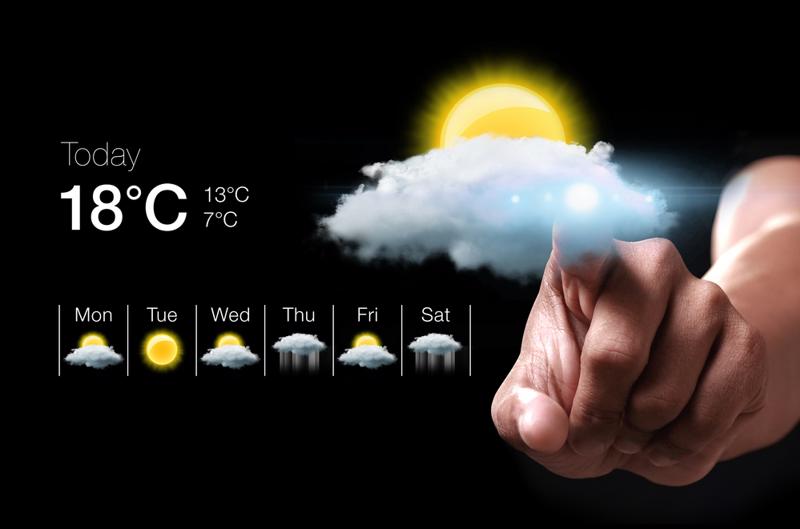
How IoT infrastructure allows for more accurate weather forecasting
By Max BurkhalterJanuary 3, 2018
Weather forecasting as a practice has existed ever since the first person wondered if it would rain the next day. Over the years, the methods have grown more advanced. The placement of weather satellites helped give a clearer picture on weather patterns as they developed. Now, however, companies have access to even more data.
Businesses can no longer plan on just snow, they can know how much, which town will be likely be hit hardest and where on the road the greatest concentration of ice will be. The Internet of Things is empowering more succinct weather forecasting than ever before.
A more sensor-filled network
According to Computerworld, the first sensors relied on by meteorologists to predict the weather were stationed primarily on airports or ocean ships. These institutions were most in need of immediate, accurate weather information and they were also large enough to store the equipment without it interfering in daily routines.
Thanks to IoT-enabled technology, these sensors - which measure factors such as light, motion, temperature, pressure and moisture - are more readily available. Weather forecasters are now able to strap this equipment into cars to provide accurate road conditions. Even most smartphones carry at least a few of these sensors. By using smartphone sensors, IoT tech enables forecasters to see a more complete map with far more points of data than just airports and shipping vessels.
The surplus of sensors also allows for more data experimentation. Meteorologists can see exactly where on the vehicle the equipment provides the most accurate results and tailor their input to prioritize that information.

Adding air quality to the mix
The surplus of sensors has lead to the tracking of not just weather but air quality. According to Data-Smart City Solutions, air quality sensors have been implemented within major U.S. cities using a variety of IoT-enabled methods. The most basic is smartphone data, which provides precise user tracking to see how often a resident is in areas with poor air quality. However this source by itself is not strong enough to provide all the necessary data so it must be paired with additional sensors.
As with the other weather equipment, air quality sensors are being stored in vehicles for more mobile data collection. The problem here is that data is captured in real time, meaning that the information stream ceases as the car leaves the area. This method by itself cannot provide a look at air pollution changes throughout the day, not unless the vehicle drives back and forth over the same area constantly.
The third method is the strongest. Air quality sensors can be built into existing infrastructure. Certain cities like Boston have even implemented Soofa benches, park benches equipped with solar panels to charge USB devices and provide ports for data collection. This method is precise and continuous, but initial installation costs are high.
"Agriculture depends on up-to-date readings on soil, temperature and moisture."
Calculating change as it happens
The Federal Highway Administration reported that roughly 445,000 people are injured each year from weather-related traffic incidents, in addition to 6,000 killed annually. In many cases, drivers and passengers leave their homes in relatively driveable conditions only to encounter an unexpected patch of severe weather on the road.
Weather forecasting also applies to specific industries in addition to general populace well-being. Agriculture depends on precise up-to-date readings on soil, temperature and moisture. Improved weather forecasting helps farmers tend to their crops more effectively, increasing harvest productivity.
Enabling the hyperlocal forecast
IBM and the Weather Channel partnered in 2016 to spearhead a hyperlocal forecasting platform aimed at using IoT-enabled weather readout technology to provide accurate weather information to all areas, especially those that were left exposed by the previous system.
This new program combines the previously established Personal Weather Station network with Watson, an AI tailored to data processing. Under the initiative, Watson is able to not only provide the previously underserved areas with accurate forecasting, it can help the area plan to best utilize these weather patterns for productive purposes, including within the agricultural industry.
While IoT-enabled technology is driving weather forecasting forward, a strong network infrastructure is required to ensure stability and fast streaming. Industries looking to increase their weather data intake should seriously consider Perle IDS industrial-grade Ethernet switches. These switches allow for the preservation of network strength in areas with extreme temperatures and conditions.
With the weather forecasting industry continuing to embrace IoT-enabled technology, faster and more stable online connections will provide a boost to accuracy and efficiency. As more technology providers offer IoT-enabled smart products, Perle will be there to provide the critical network infrastructure required for uninterrupted data streaming. Connect with us today to learn more about our work in the weather forecasting space.



